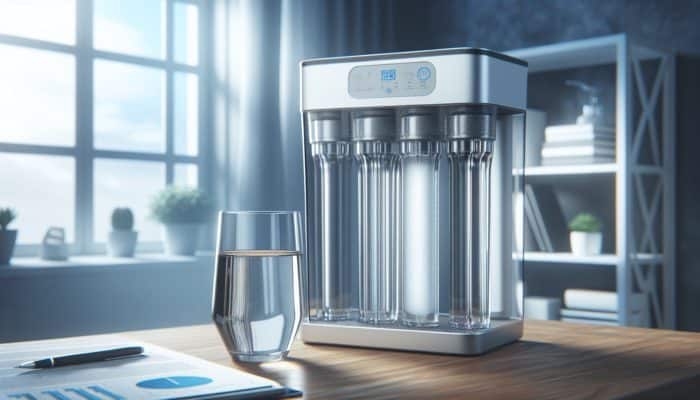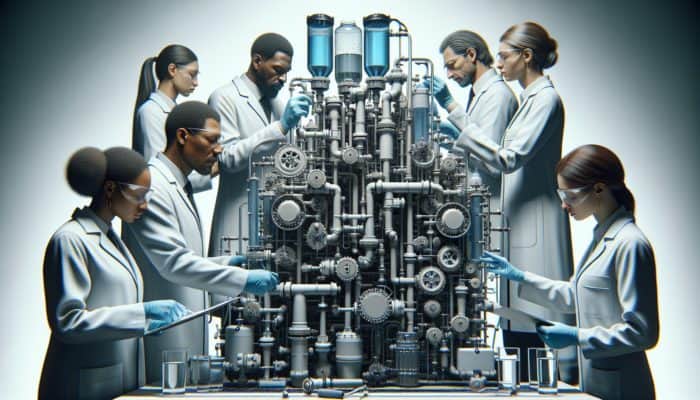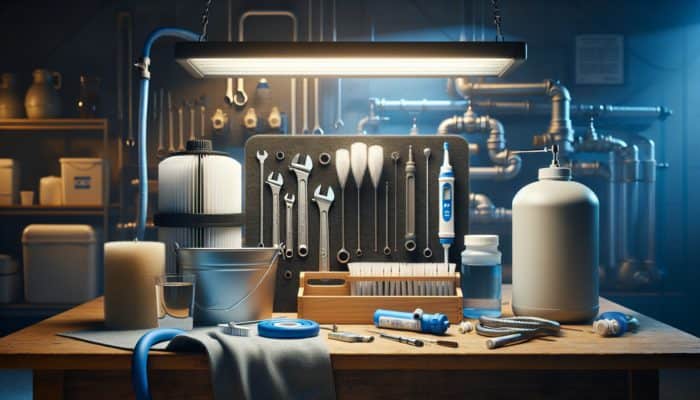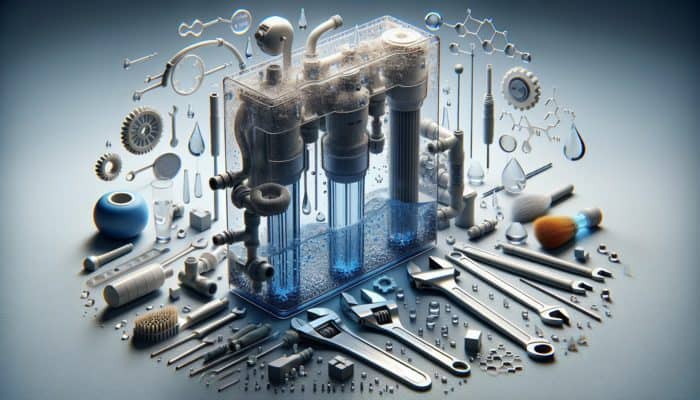Significance of Consistent Maintenance for Water Filters
Why is Consistent Maintenance Essential for Water Filters?

Water Filter Maintenance: Maintaining your water filter is not just a recommendation; it’s a critical requirement for the overall health and efficiency of your household. Engaging in regular maintenance guarantees that your filter operates at peak performance, extends its lifespan, and ultimately ensures the purity and safety of the water you consume. Here are several compelling benefits of prioritising consistent maintenance:
- Enhanced Water Quality: Consistent maintenance ensures that harmful contaminants are effectively eliminated, providing you with safer drinking water.
- Prolonged Lifespan: Well-maintained filters tend to last longer, resulting in savings on replacements.
- Financial Savings: Routine upkeep can avert costly repairs or replacements in the future.
- Optimized Efficiency: Filters perform at their best when regularly maintained, resulting in superior filtration.
- Confidence in Water Safety: Knowing that your water is clean and safe fosters peace of mind in your household.
Prioritising the longevity of your water filter isn’t solely about financial savings; it’s about cultivating a healthy environment for you and your family. Each time you neglect maintenance, you jeopardise the filter’s effectiveness, potentially leading to health risks as contaminants build up unchecked.
How Does Maintenance Affect Water Quality?
The connection between regular maintenance and water quality is both direct and significant. When filters are neglected, they can become clogged with sediment, resulting in diminished flow rates and inadequate filtration. This increased pressure can also cause the filter material to degrade, allowing harmful substances to pass through. It is essential to conduct routine checks and maintenance to guarantee that your water remains free from harmful bacteria, heavy metals, and various pollutants.
A particularly telling example can be observed in communities that rely on well water. These areas frequently encounter unique contamination challenges, including high levels of nitrates and heavy metals. Without regular maintenance, a water filter can swiftly become ineffective, leading to severe health ramifications. This critical aspect of maintenance emphasizes the importance of regularly checking and replacing filters, ensuring that the water flowing from your tap remains pure and safe for consumption.
Why is Regular Maintenance a Cost-Effective Strategy?
Regularly maintaining your water filters is a wise financial strategy. It’s easy to perceive the cost associated with filter replacements or professional services as an expense, but neglecting routine upkeep can lead to significantly higher costs over time. Filters that are not properly maintained are more likely to fail, necessitating expensive repairs or even the complete replacement of the system, which can impose a heavy financial burden.
Consider this: a simple cleaning of a carbon filter might only cost a few pounds and require minimal time, but failing to address this could lead to system failure, with potential costs soaring into the hundreds of pounds. By investing a small amount of time and money today, you can avoid hefty expenses tomorrow. Moreover, a well-maintained water filter operates efficiently, utilising less energy and providing clean water without the need for costly bottled alternatives.
Professional Perspectives on Water Filter Maintenance

What Are the Best Practices for Maintaining a Water Filter?
Maintaining a water filter effectively is an art that merges attention to detail with best practices. Experts recommend several optimal practices to keep your filtration system functioning optimally. These practices not only safeguard the integrity of your water supply but also enhance the longevity of your filter.
One effective strategy is to conduct a *monthly visual inspection*. This involves checking for any leaks or signs of wear and tear. Additionally, it’s crucial to *replace filters according to the manufacturer’s guidelines*, which typically suggest changing them every 6 to 12 months, depending on usage. In situations of high demand, such as families with multiple members or areas with heavy sediment, filters may require more frequent changes.
Another recommended practice is to *flush your system regularly*. This entails running water through the filter for a few minutes to clear out any accumulated debris. Other best practices include keeping a log of maintenance activities, using only manufacturer-recommended replacement parts, and ensuring that the installation area is clean and free from contaminants. By adhering to these practices, you can significantly enhance the performance of your filter.
How Frequently Should Maintenance Be Conducted?
The frequency of water filter maintenance can vary widely based on various factors, including filter type, water quality, and usage rates. Experts suggest adhering to a maintenance schedule tailored to your specific situation. For instance, if you reside in an area with hard water or high sediment levels, you may need to perform maintenance more frequently than the standard recommendation.
For conventional activated carbon filters, a good rule of thumb is to replace them every 6 months, whereas reverse osmosis systems may require more extensive checks every 2 years. To determine the appropriate frequency, assess your water usage patterns. If you notice decreased flow or unusual tastes, it may indicate that maintenance is overdue. Always consider the manufacturer's recommendations as your primary guide and adjust your schedule based on your observations and experiences.
What Essential Tools Are Needed for Effective Maintenance?

Having the right tools available is vital for effective water filter maintenance. A well-equipped toolkit not only simplifies tasks but also enhances their efficacy. Essential tools include:
- Wrench: A filter wrench is essential for opening filter housings without causing damage.
- Cleaning Brushes: Soft brushes are useful for clearing out any accumulated sediment without harming filter materials.
- Bucket: A bucket is necessary for managing spills during filter changes.
- Hoses: Hoses can help flush out filters and systems efficiently.
- pH Test Strips: These are beneficial for checking the pH level of your water before and after filtration.
Investing in a reliable toolkit not only prepares you for routine maintenance but also equips you to tackle unexpected issues that may arise. By combining these tools with a basic understanding of how your filter operates, you’ll be well on your way to mastering water filter maintenance.
What Are the Typical Challenges Faced During Maintenance?
Water filter maintenance, while essential, can present its own set of challenges that even seasoned DIY enthusiasts may encounter. One of the most common issues is *clogging*. Over time, filters can become saturated with contaminants, leading to reduced flow rates. This challenge necessitates not only regular checks but also a clear understanding of when to replace the filter.
Another frequent dilemma is *leakage*. Filters that are not fitted correctly can leak, posing risks to both the filter’s performance and your home. This often occurs due to improper installation or the deterioration of seals over time. To overcome this challenge, ensure that seals are regularly examined and replaced as needed.
Lastly, keeping track of maintenance schedules can be a hurdle for many users. Without a proper log, it's easy to forget when filters need to be changed or when the last maintenance check was performed. Utilising apps or simple journals can help keep these tasks organised, ensuring your water remains clean and your filter operates efficiently.
How Does Maintenance Influence Filter Performance?
Regular maintenance has a significant impact on the performance of your water filter. Filters that are consistently cleaned and maintained operate at higher efficiencies, which directly correlates with the quality of water produced. Neglecting maintenance can lead to a cumulative decline in performance, ultimately rendering the filter ineffective in eliminating contaminants.
For instance, research on residential water filtration systems has revealed that filters subjected to regular maintenance can remove up to 99% of harmful bacteria. In contrast, poorly maintained filters struggle to achieve a 50% efficiency rate. This stark contrast highlights how a few simple maintenance practices can safeguard your health and ensure that the water you consume is safe.
By engaging in proactive care, you are essentially investing in the longevity and performance of your filtration system. This not only preserves the quality of your drinking water but also spares you from more significant issues and costs in the future.
Common Problems and Resolutions
Identifying Frequent Water Filter Problems
Recognising common water filter problems is the initial step towards effective maintenance. Numerous issues can arise, often manifesting as changes in water quality or flow. Here are several common problems and their indicators:
- Decreased Water Flow: A notable drop in flow rate frequently indicates a clogged filter.
- Unusual Tastes or Odours: Strange tastes can signal filter saturation or contamination.
- Cloudy Water: Cloudiness may indicate that the filter is not effectively removing particulates.
- Leaks: Water pooling around the filter housing can signal improper sealing or a damaged filter.
- Increased Pressure: Higher-than-normal pressure readings can indicate a blockage or malfunction.
Staying vigilant and observant of these signs is crucial. By identifying issues early, you can mitigate potential health risks and ensure that your water filter continues to perform effectively.
How Can You Resolve These Common Issues?
Many prevalent water filter issues can be addressed with simple do-it-yourself (DIY) solutions. For instance, if you are experiencing reduced water flow, begin by unclogging the filter. This often involves removing and thoroughly cleaning it. For many types of activated carbon filters, a gentle rinse under running water can yield significant improvements.
If you detect unusual tastes, consider replacing the filter entirely if cleaning does not rectify the issue. It’s essential to adhere to the manufacturer’s guidelines for replacement. For leaks, examine all fittings and seals closely—tightening loose connections or replacing worn seals typically resolves the problem.
If cloudy water persists, it may indicate that a filter is no longer effective, necessitating its replacement. Promptly addressing these issues can prevent further complications and maintain the integrity of your water source.
When Should You Consult a Professional for Help?
While many water filter maintenance tasks can be handled independently, recognising when to seek professional assistance is crucial. If you encounter persistent problems after performing basic maintenance, such as ongoing leaks or if flow rates do not improve with cleaning, it’s time to consult an expert.
Additionally, if your filter system is complex, such as a reverse osmosis or ultraviolet filtration system, professional help may be necessary for proper maintenance and troubleshooting. These systems require specialised knowledge that may exceed typical DIY capabilities.
Finally, when in doubt, don’t hesitate to reach out to a professional. They can provide an evaluation of your system, ensuring it operates effectively and safely. Professional checks can uncover hidden issues that might otherwise go unnoticed, ultimately ensuring that your water quality remains uncompromised.
Preventive Maintenance Strategies
Establishing a routine for preventive maintenance can significantly reduce the occurrence of common issues. Here’s a checklist of tasks that should be integrated into your maintenance routine:
- Monthly Inspections: Check for leaks, cracks, or visible wear.
- Filter Changes: Follow the manufacturer's schedule for filter replacements.
- Flushing System: Flush the system monthly to prevent buildup.
- Cleaning Components: Regularly clean any components that can harbour bacteria.
- Record Keeping: Maintain a log of maintenance activities and filter changes.
By incorporating these preventive measures, you’ll keep your water filter operating smoothly while ensuring the high quality of your drinking water remains intact. It’s a proactive approach that pays off in the long run, both in terms of health and financial savings.
Understanding Filter Lifespan and Replacement Timing
Knowing when to replace your water filter is essential for maintaining clean water. Filter lifespans can vary significantly based on filter type and usage patterns. For example, activated carbon filters typically last between 6 and 12 months, while reverse osmosis membranes can last anywhere from 2 to 5 years, depending on water quality and usage.
Signs that indicate a replacement is necessary include visible discolouration, unusual tastes or odours, and inadequate flow rates. Understanding these lifespans and their associated signs ensures that you do not inadvertently compromise your water quality by delaying essential replacements. Regular checks and timely replacements can make a significant difference in ensuring your water remains as pure as possible.
Different Types of Water Filters and Their Maintenance Needs
What Are the Various Types of Water Filters?
Understanding the different types of water filters is essential for effective maintenance. The most common types include activated carbon filters, reverse osmosis systems, and UV purification systems, each with its own unique maintenance requirements.
Activated carbon filters are highly effective in removing chlorine, sediment, and volatile organic compounds. However, they require regular replacement and cleaning to function optimally. Reverse osmosis systems, on the other hand, eliminate a broader range of contaminants, including heavy metals and salts, but necessitate periodic checks and membrane replacements. UV systems excel at disinfecting water without the use of chemicals, but their lamps require annual replacement to maintain effectiveness.
By familiarising yourself with the specific type of filter you have, you can tailor your maintenance practices accordingly, ensuring optimal performance and longevity.
Maintenance Essentials for Activated Carbon Filters
Activated carbon filters are popular due to their ability to enhance the taste of water by removing harmful chemicals and impurities. Regular maintenance is imperative to ensure they function effectively. These filters typically require replacement approximately every 6 to 12 months, depending on the contaminant levels in your water.
Cleaning the filter housing periodically is also essential. Rinsing it out and checking for any buildup can help prevent clogging. If you notice a decline in water flow or an unusual taste, it’s time to inspect or replace the filter. Furthermore, always ensure that the carbon itself is stored in a dry, cool location to maintain its effectiveness.
Using filtered water exclusively for drinking and cooking can also help extend the lifespan of the activated carbon filter, as it reduces the amount of work the filter has to do, thereby allowing it to function efficiently for a longer period.
Maintenance Suggestions for Reverse Osmosis Systems
Reverse osmosis systems are among the most advanced water filtration systems available. They provide thorough filtration, but their maintenance needs are specific and must be strictly adhered to for optimal performance. The membranes in these systems should typically be replaced every 2 to 5 years, depending on usage and the quality of the water.
Regularly checking and replacing pre-filters and post-filters is equally vital. These filters shield the reverse osmosis membrane and should be changed every 6 to 12 months. Additionally, periodic sanitisation of the system is recommended to prevent bacterial growth.
Monitoring water pressure is another crucial aspect of maintaining the system. If you notice a pressure drop, it may indicate a clogged pre-filter or the need for membrane replacement. By staying on top of these tasks, you can ensure that your reverse osmosis system continues to deliver high-quality water for years to come.
Cleaning and Replacing Water Filter Components
What Steps Should You Follow to Clean a Water Filter?
Cleaning your water filter is essential for maintaining its performance and extending its lifespan. Here are the general steps to follow for cleaning various types of filters:
- Turn Off Water Supply: Always start by shutting off the water supply to prevent spills.
- Remove Filter: Use a wrench to remove the filter from its housing carefully.
- Rinse Thoroughly: Rinse the filter under warm running water to eliminate any debris.
- Use Cleaning Solution: For activated carbon filters, a mild vinegar solution can be effective for deeper cleaning.
- Dry Properly: Allow the filter to dry completely before reinstalling it to prevent mould growth.
By following these steps, you can maintain the efficiency and effectiveness of your water filter, ensuring that it continues to provide safe and clean drinking water.
When Should You Consider Replacing Filter Parts?
Knowing when to replace components of your water filter system is crucial for maintaining water quality. The lifespan of a filter varies significantly depending on the type of filter and its usage. For example, activated carbon filters typically require replacement every 6 to 12 months, while reverse osmosis membranes may last between 2 and 5 years.
Signs indicating a need for replacement include visible wear, reduced water flow, unusual tastes or odours, and cloudy water. If you observe any of these signs, it’s critical to replace the affected components promptly. Regularly consulting the manufacturer’s guidelines can also help you determine the best replacement schedule.
Moreover, keeping a close eye on your filter’s performance and any changes in water quality can help you identify when parts need to be replaced. By being vigilant and proactive about replacements, you can ensure your water remains pure and safe for consumption.
How to Dispose of Old Filters Safely
Proper disposal of old water filters is essential for environmental safety. Many filters contain materials that can be harmful if not disposed of correctly. Always check if your local waste management guidelines provide specific instructions for disposing of filters.
For most activated carbon filters, you can place them in standard waste; however, it’s advisable to encapsulate them in a bag to prevent potential leakage of contaminants. If your filter system uses membranes or cartridges, check if the manufacturer offers a recycling programme. Many brands have initiatives for returning used filters for recycling or safe disposal.
Additionally, avoid flushing filters down the toilet or discarding them loosely in landfills. Taking the time to dispose of your old filters responsibly not only protects the environment but also promotes a healthier planet for future generations.
What Tools and Materials Are Necessary for Filter Maintenance?
Having the appropriate tools and materials on hand is crucial for effective water filter maintenance. Essential items include:
- Filter Wrench: To easily remove filter housings without causing damage.
- Bucket: To catch any residual water during changes.
- Cleaning Brushes: For thorough cleaning of filter housings and components.
- Replacement Filters: Always keep the correct replacement filters on hand to avoid delays.
- pH Test Kits: To check the water quality before and after filtration.
With these tools, you can ensure that your maintenance routine is efficient and effective, allowing your water filter to operate optimally for years to come. Investing in quality tools will pay dividends in the long run by extending the life and efficacy of your system.
Research-Validated Benefits of Water Filter Maintenance
How Does Maintenance Enhance Health Outcomes?
Numerous studies support the link between regular water filter maintenance and health benefits. Consistent upkeep of your filtration system significantly improves the quality of your drinking water, which can lead to long-term health benefits. Ensuring that filters are clean and functioning properly prevents the proliferation of harmful bacteria and contaminants, thereby safeguarding against waterborne diseases.
For instance, households that routinely maintain their water filters report fewer gastrointestinal illnesses, attributed to the elimination of pathogens and other harmful substances. Regular maintenance helps to ensure that filters effectively reduce pollutants, leading to improved health outcomes. As such, a commitment to maintenance is not merely about convenience; it’s a proactive step towards securing better health for you and your loved ones.
What Are the Environmental Advantages of Maintaining Water Filters?
Proper maintenance of water filters also brings significant environmental benefits. When filters are regularly maintained, they not only function better but also last longer. This longevity reduces the frequency of replacements and the subsequent waste generated by discarded filters.
Moreover, efficient water filters decrease reliance on bottled water, leading to a reduction in plastic waste. By maintaining filters and using them effectively, households can make a positive contribution to environmental sustainability. A well-maintained filter system can also lead to reduced water wastage, promoting more efficient use of this precious resource.
Overall, responsible water filter maintenance is a key component in minimising environmental impact, making it an essential practice for eco-conscious consumers.
How Does Maintenance Affect the Longevity of Filters?
Regular maintenance has a direct correlation with the longevity of your water filter. Filters that receive consistent attention tend to last significantly longer than those that are neglected. For instance, studies indicate that filters with a maintenance routine can last up to 50% longer compared to those that do not receive regular upkeep.
This increase in longevity also translates into financial savings. By routinely replacing components, cleaning systems, and ensuring optimal function, you mitigate the need for costly repairs or replacements. Real-world examples abound where households that prioritise maintenance observe their filter systems exceeding the expected lifespan, proving that a little attention can yield significant rewards.
By understanding the relationship between maintenance and filter longevity, users can make informed decisions that benefit both their wallets and their health.
Comparing DIY Maintenance and Professional Services
What Maintenance Tasks Can You Handle Yourself?
Many water filter maintenance tasks can be performed independently, making DIY maintenance both accessible and cost-effective. Regularly checking for leaks, cleaning filter housings, and replacing cartridges are all manageable tasks for most homeowners.
Another critical DIY task is flushing the system. This straightforward practice can prevent buildup and ensure effective filtration. Many users can also manage basic troubleshooting, like identifying reduced flow rates or unusual tastes, allowing them to take action before issues escalate.
In addition to these tasks, maintaining a log of maintenance activities and performing visual inspections can help catch potential problems early. By being proactive and taking personal responsibility for your water filter maintenance, you can extend the lifespan of your system while ensuring the quality of your drinking water.
When Should You Consider Hiring a Professional?
While many maintenance tasks can be conducted at home, certain situations warrant professional assistance. If your filter system is complex, such as a multi-stage reverse osmosis system, seeking a professional might be the best course of action. These systems often require specialised knowledge and tools for proper maintenance and repair.
Additionally, if you encounter issues that require more than simple fixes, such as persistent leaks or unusual pressure readings, a professional can provide a comprehensive evaluation and effective solutions. It’s essential to recognise when a task exceeds your comfort level or expertise, as attempting to fix complex issues without proper experience can lead to further complications.
Professional services can ensure your water filtration system continues to operate optimally, providing peace of mind in knowing that experts are managing your water quality.
Cost Comparison: DIY Maintenance Versus Professional Services
Comparing the costs of DIY maintenance against professional services can help you make informed decisions. DIY maintenance typically involves minimal expenses, such as purchasing replacement filters and necessary cleaning tools, which may range from £20 to £100 annually, depending on your system.
In contrast, hiring a professional can incur higher costs, often ranging from £75 to £200 for routine maintenance checks or repairs. While this might appear steep, consider the potential savings from avoiding expensive repairs due to neglect.
Ultimately, the choice between DIY and professional services depends on your comfort level, the complexity of your system, and your willingness to invest time and effort into maintenance. Finding a balance between DIY tasks and professional assistance can help you maintain both cost-effectiveness and water quality.
Maintaining Water Filters in Various Environments
How to Effectively Maintain Filters in Residential Settings?
Home water filters necessitate specific maintenance routines tailored to ensure clean water for families. Routine checks should include inspecting connections for leaks, flushing the system monthly, and replacing filters according to the manufacturer's guidelines.
In households with multiple occupants or high water usage, filters may need to be changed more frequently. For instance, families residing in urban areas with high sediment levels might find that their activated carbon filters need replacement every 3 to 6 months.
Additionally, establishing a visual log can help track maintenance activities. Setting reminders for filter changes can streamline the process and ensure that your household consistently enjoys clean and safe drinking water.
How to Maintain Filters in Commercial Environments?
Commercial water filters often experience higher usage and may require more tailored maintenance strategies. Businesses, such as restaurants and offices, typically have elevated water consumption rates, leading to more frequent clogging and wear.
Establishing a maintenance schedule that accounts for the increased demand is essential. Filters in commercial settings should be checked monthly, with routine replacements occurring every 3 to 6 months, depending on usage and the type of filter.
Additionally, training staff on basic maintenance practices can help ensure filters remain in optimal condition. Regular professional inspections can also be beneficial for larger systems, ensuring compliance with health regulations and maintaining water quality for both employees and customers.
What About Water Filters Used in Industrial Settings?
Industrial water filters face unique challenges and maintenance needs due to their scale and intensity of use. These systems often process large volumes of water, which can lead to accelerated wear and tear.
Regular maintenance protocols in industrial settings should include daily checks of pressure levels and flow rates, as well as routine cleaning of pre-filters and membranes. Due to the complexity of these systems, having dedicated personnel or contracted services specifically trained in industrial filtration systems is crucial.
Moreover, establishing a comprehensive maintenance and monitoring programme can help prevent costly downtimes and ensure that water quality remains at standard levels. Such proactive measures can significantly extend the lifespan of industrial filtration systems and safeguard water quality in high-demand environments.
How to Maintain Filters in Outdoor and Recreational Settings?
Outdoor and recreational water filters face unique challenges due to their exposure to environmental conditions. These filters often require specialised maintenance to ensure they provide safe water during activities such as camping, hiking, or fishing.
Routine cleaning after every use is essential; many portable filters require thorough rinsing to eliminate debris. It’s also critical to dry them completely before storage to prevent mould and degradation.
Inspecting seals and components for wear is also vital, as outdoor filters are exposed to tougher conditions than home systems. Establishing a cleaning and inspection routine after each outing can ensure that these filters remain reliable, providing safe drinking water for all your adventures.
Frequently Asked Questions
1. How often should I change my water filter?
This depends on the filter type; generally, activated carbon filters should be changed every 6 to 12 months, while reverse osmosis filters may require replacement every 2 to 5 years.
2. What signs indicate that my water filter needs maintenance?
Look for reduced water flow, unusual tastes, cloudy water, and leaks as key indicators that maintenance is needed.
3. Can I clean my water filter, or does it need to be replaced?
Many filters can be cleaned, but if they show signs of wear or reduced effectiveness, replacement is often the best option.
4. What tools do I need for water filter maintenance?
Essential tools include a filter wrench, bucket, cleaning brushes, replacement filters, and pH test kits.
5. Is professional maintenance necessary for water filters?
While many tasks can be done as a DIY project, professional maintenance is advisable for complex systems or persistent issues that require more than simple fixes.
6. How does regular maintenance improve water quality?
Regular maintenance prevents the buildup of contaminants, ensuring that filters operate efficiently and effectively remove harmful substances from water.
7. What are the environmental benefits of maintaining my water filter?
Proper maintenance reduces waste by extending the life of the filters and decreasing reliance on bottled water, thereby minimizing plastic pollution.
8. How can I dispose of old water filters safely?
Check local guidelines for disposal; many filters can be placed in the trash, while some manufacturers offer recycling programmes.
9. What is the average lifespan of a water filter?
Activated carbon filters typically last 6 to 12 months, while reverse osmosis membranes can last 2 to 5 years, depending on usage and the quality of the water.
10. Can neglecting maintenance affect my health?
Yes, neglecting maintenance can lead to contaminated water, increasing the risk of waterborne diseases and health issues. Regular upkeep is essential for safe drinking water.
Explore our world on X!
Knife Sharpening Tips: Master the Art of Edge
Master the Art of Knife Sharpening Techniques Grasping the Significance of Knife Angles Knife Sharpening Tips: Understanding knife angles is crucial when sharpening your blades. Each type of knife, from the delicate yanagiba used by sushi chefs to the sturdy butcher's cleaver, is designed with a specific sharpening angle in mind. Generally, most kitchen knives […]
Fire Pit Construction: Essential Tips and Techniques
Comprehensive Guide to Fire Pit Construction What Exactly Is a Fire Pit? Fire Pit Construction: A fire pit is an outdoor feature specifically designed to safely contain a fire, primarily used for creating ambience, providing warmth, or for cooking purposes. These adaptable installations serve a dual role: they enhance the visual appeal of outdoor areas […]
Water Filter Upgrades: A Comprehensive Guide
The Crucial Need for Upgrading Your Water Filters Water Filter Upgrades: For anyone prioritising the quality and safety of their drinking water, upgrading water filters is not merely a choice but an essential action. As our awareness of water contaminants and their potential health implications expands, it becomes increasingly vital to ensure that our filtration […]
Post-Disaster Gardening: A Universal Guide
Revitalising Your Garden in the Wake of a Catastrophe Post-Disaster Gardening: When disaster strikes, the landscape of your garden may appear barren and forlorn; yet, this is the pivotal moment when hope and renewal begin. Embracing post-disaster gardening transcends mere seed planting; it embodies the nurturing of life's essence in a world yearning for restoration. […]





